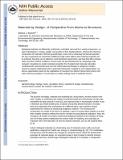| dc.contributor.author | Buehler, Markus J. | |
| dc.date.accessioned | 2014-09-05T18:14:16Z | |
| dc.date.available | 2014-09-05T18:14:16Z | |
| dc.date.issued | 2013-02 | |
| dc.identifier.issn | 0883-7694 | |
| dc.identifier.issn | 1938-1425 | |
| dc.identifier.uri | http://hdl.handle.net/1721.1/89211 | |
| dc.description.abstract | Biological materials are effectively synthesized, controlled, and used for a variety of purposes in Nature—in spite of limitations in energy, quality, and quantity of their building blocks. Whereas the chemical composition of materials in the living world plays some role in achieving functional properties, the way components are connected at different length scales defines what material properties can be achieved, how they can be altered to meet functional requirements, and how they fail in disease states and other extreme conditions. Recent work has demonstrated this using large-scale computer simulations to predict materials properties from fundamental molecular principles, combined with experimental work and new mathematical techniques to categorize complex structure-property relationships into a systematic framework. Enabled by such categorization, we discuss opportunities based on the exploitation of concepts from distinct hierarchical systems that share common principles in how function is created, even linking music to materials science. | en_US |
| dc.description.sponsorship | National Science Foundation (U.S.) (CAREER 0642545) | en_US |
| dc.description.sponsorship | United States. Office of Naval Research (PECASE N00014-10-1-0562) | en_US |
| dc.description.sponsorship | United States. Air Force Office of Scientific Research (FA9550-11-1-0199) | en_US |
| dc.description.sponsorship | National Institutes of Health (U.S.) (U01 EB014976) | en_US |
| dc.language.iso | en_US | |
| dc.publisher | Cambridge University Press (Materials Research Society) | en_US |
| dc.relation.isversionof | http://dx.doi.org/10.1557/mrs.2013.26 | en_US |
| dc.rights | Creative Commons Attribution-Noncommercial-Share Alike | en_US |
| dc.rights.uri | http://creativecommons.org/licenses/by-nc-sa/4.0/ | en_US |
| dc.source | PMC | en_US |
| dc.title | Materials by design—A perspective from atoms to structures | en_US |
| dc.type | Article | en_US |
| dc.identifier.citation | Buehler, Markus J. “Materials by design—A Perspective from Atoms to Structures.” MRS Bulletin 38, no. 02 (February 2013): 169–176. | en_US |
| dc.contributor.department | Massachusetts Institute of Technology. Department of Civil and Environmental Engineering | en_US |
| dc.contributor.department | Massachusetts Institute of Technology. School of Engineering | en_US |
| dc.contributor.mitauthor | Buehler, Markus J. | en_US |
| dc.relation.journal | MRS Bulletin | en_US |
| dc.eprint.version | Author's final manuscript | en_US |
| dc.type.uri | http://purl.org/eprint/type/JournalArticle | en_US |
| eprint.status | http://purl.org/eprint/status/PeerReviewed | en_US |
| dspace.orderedauthors | Buehler, Markus J. | en_US |
| dc.identifier.orcid | https://orcid.org/0000-0002-4173-9659 | |
| mit.license | OPEN_ACCESS_POLICY | en_US |
| mit.metadata.status | Complete | |
